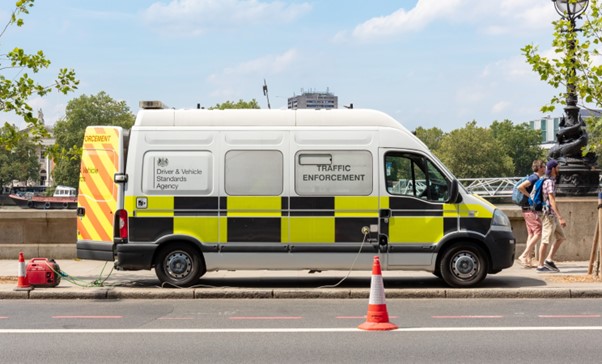
Susie Jones
Wyjaśnienie kontroli DVSA dla pojazdów ciężarowych
Utworzony: 08.08.2024
•
Aktualizacja: 08.08.2024
Podczas swojej kariery jako kierowca ciężarówki możesz zostać zatrzymany przez Agencję Standardów Kierowców i Pojazdów (DVSA). Dla początkujących kierowców ciężarówek może to być zniechęcający proces. Jednak zrozumienie podstawowych aspektów kontroli ciężarówek DVSA może sprawić, że proces ten będzie mniej stresujący.
Kim jest DVSA?
Według Gov.uk, DVSA jest odpowiedzialna za "przeprowadzanie kontroli drogowych kierowców i pojazdów komercyjnych, aby upewnić się, że przestrzegają zasad bezpieczeństwa i utrzymują swój pojazd w stanie bezpiecznym".
DVSA może przeprowadzać wyrywkowe kontrole ciężarówek i wydawać zakazy. Zakazy uniemożliwiają kierowcy ciężarówki prowadzenie pojazdu do czasu rozwiązania problemu z pojazdem.
Policja ma również prawo zatrzymać kierowcę ciężarówki i przeprowadzić podobną kontrolę.
Jak wyglądają egzaminatorzy DVSA?
Egzaminatora DVSA można rozpoznać na kilka sposobów. Egzaminatorzy noszą żółte kamizelki odblaskowe z logo DVSA i zawsze mają kartę nakazu. Ich pojazdy mają czarno-żółty nadruk z logo DVSA na masce.

Co się stanie, jeśli zostaniesz zatrzymany?
Niezatrzymanie się na żądanie egzaminatora DVSA jest wykroczeniem. Jeśli egzaminator poprosi o zatrzymanie się, przeprowadzi kontrolę na poboczu drogi lub w specjalnym miejscu testowym. Głównym celem tych zatrzymań jest utrzymanie niebezpiecznych pojazdów z dala od dróg.
Egzaminator przeprowadzi następujące obowiązkowe kontrole:
Sprawdzenie dopuszczalnej masy ładunku i typu ładunku
Sprawdzanie usterek mechanicznych i przydatności do ruchu drogowego
Zapewnienie poprawności zapisów tachografu
Upewnij się, że posiadasz ważne prawo jazdy.
Jak długo trwa kontrola DVSA?
Kontrola DVSA trwa średnio 15 minut. Jednak w przypadkach, gdy ciężarówka nie spełnia wymogów bezpieczeństwa, może to potrwać dłużej. Egzaminator musi przeprowadzić niezbędne kontrole, niezależnie od czasu.
Jak upewnić się, że pojazd jest zdatny do jazdy?
Obowiązkiem kierowcy jest upewnienie się, że jego ciężarówka nadaje się do jazdy. Przed każdą podróżą zaleca się przeprowadzenie kontroli pojazdu.
Sprawdź następujące elementy:
Światła
Wskaźniki
Paliwo i olej
Opony
Mocowania kół
Bodywork
Sprzęg przyczepy
Ładunek i inny sprzęt
Kontrola pojazdu w kabinie (np. pasów bezpieczeństwa, klaksonu, wycieraczek, spryskiwaczy, układu kierowniczego i wskaźnika wysokości).
Ponadto obowiązkiem kierowcy ciężarówki jest pisemne zgłaszanie wszelkich usterek swojej organizacji. Powinny one zawierać następujące informacje:
Znak rejestracyjny lub identyfikacyjny pojazdu
Data inspekcji
Szczegóły dotyczące usterek
Imię i nazwisko osoby zgłaszającej usterki.
Obowiązki operatora
Operatorzy pojazdów są odpowiedzialni za zapewnienie bezpieczeństwa swoich pojazdów i muszą wykonywać następujące czynności:
Operator musi zapewnić regularne kontrole bezpieczeństwa wszystkich pojazdów użytkowych.
Muszą upewnić się, że ich kierowcy rozumieją, jakie kontrole należy przeprowadzić.
Zakazy drogowe
Jeśli ciężarówka nie nadaje się do jazdy, DVSA może wydać dwa różne zakazy - natychmiastowy lub opóźniony.
Natychmiastowe powiadomienie o zakazie:
Może wejść w życie natychmiast
W większości przypadków spowoduje to unieruchomienie pojazdu
Natychmiastowe zakazy mogą skutkować oskarżeniem.
Opóźnione powiadomienie o zakazie:
Operator ma do 10 dni na rozwiązanie problemów
Po upływie dziesięciu dni funkcjonariusze ponownie sprawdzą pojazd
Zakazy muszą zostać usunięte przed rozpoczęciem jazdy.
Zakaz dopuszczenia do ruchu drogowego
Jeśli ciężarówka ma problemy mechaniczne lub nadwozie i wyposażenie są niskiej jakości, zostanie wydany zakaz dopuszczenia do ruchu drogowego. W przypadku pojazdów spoza Wielkiej Brytanii kierowca otrzyma natychmiastowy zakaz. W przypadku operatorów z Wielkiej Brytanii rodzaj zakazu będzie zależał od tego, jak poważna jest usterka.
Drobne usterki:
Drobne usterki mogą skutkować opóźnionym wydaniem zakazu
Operator będzie miał do dziesięciu dni na usunięcie wszelkich usterek
Ponowna inspekcja zostanie przeprowadzona po upływie dziesięciu dni.
Poważne wady:
Kierowca otrzyma zakaz oznaczony literą "S" za poważną usterkę
Zakaz oznaczony literą "S" pojawia się, gdy występuje problem z konserwacją
Jeśli egzaminator zdecyduje, że nie ma bezpośredniego ryzyka, zakazy mogą zostać opóźnione
Pojazd zostanie unieruchomiony i może zostać wszczęte postępowanie karne.
Zakaz oznaczony literą "S" nie będzie obowiązywał w następujących przypadkach:
Jeśli podczas podróży wystąpił problem
Problem nie mógł zostać wykryty (np. wada spodnia).

Zakazy przeładowania
Jeśli pojazd jest przeciążony, egzaminator DVSA może go unieruchomić. Alternatywnie, egzaminator może skierować ciężarówkę do pobliskiej lokalizacji, gdzie ładunek może zostać ponownie rozłożony lub usunięty. Operator pojazdu otrzyma powiadomienie.
Zakazy dotyczące godzin pracy kierowcy
Kierowcy, którzy nie przestrzegają zasad dotyczących tachografu i godzin pracy kierowcy, otrzymają zakaz. Może to skutkować grzywną, oskarżeniem lub unieruchomieniem pojazdu.
Czytaj więcej o [zasady i przepisy dotyczące tachografów] (https://https://snapacc.com/newsroom/tachograph-rules-made-easy/)
Chociaż egzaminy DVSA mogą być zniechęcającą perspektywą dla kierowców ciężarówek, jest to niezaprzeczalnie pozytywna siła dla bezpieczeństwa na drogach. Upewnienie się, że przeprowadziłeś prawidłowe kontrole i przestrzegasz podstawowych zasad i przepisów, zaowocuje gładkim przejściem egzaminu DVSA.
Jak długo trzeba przechowywać arkusze usterek ciężarówek?
Wdrożenie systemu zgłaszania usterek może być pierwszą linią obrony przy wykazywaniu, że pojazdy są w stanie zdatnym do jazdy. Usuwanie usterek powinno być zgłaszane i przechowywane przez okres do 15 miesięcy. W przypadku braku usterek firma powinna przechowywać dokumentację, aby upewnić się, że kierowcy przeprowadzają kontrole.
Jak często potrzebujesz badań lekarskich, aby zachować prawo jazdy?
Aby uzyskać i utrzymać licencję HGV, należy obowiązkowo przejść badania lekarskie HGV - bez nich licencja nie zostanie wydana.
W przypadku kierowców poniżej 45. roku życia badania lekarskie trwają do 45. urodzin. Jednak po osiągnięciu tego wieku będziesz musiał zdawać test medyczny co pięć lat, aż do 65 roku życia. Kierowcy w wieku 65 lat i starsi muszą przechodzić badania lekarskie co roku.



